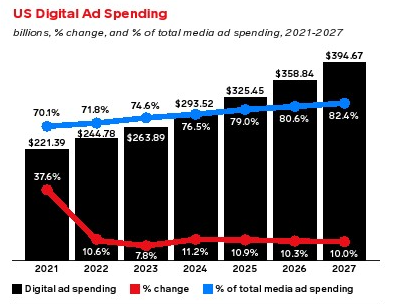Tue May 13
Scaling New Heights: Digital Ad Spending Surges and Anticipated Growth Ahead
 2023-08-07
2023-08-07
The digital advertising industry is currently experiencing a significant advancement, as indicated by the winter update of the MAGNA Global Advertising Forecast. This forecast suggests that digital ad sales are projected to increase by 8% and reach a staggering $557 billion. This growth can be attributed to various organic factors, including the rising prominence of e-commerce and shifts in media consumption patterns. Digital advertising, which constitutes 65% of total advertising sales, continues to break records and exhibit sustained expansion. To gain a competitive edge in this market, numerous companies and brands are allocating additional resources towards their digital advertising initiatives.
Undoubtedly, the surge in digital advertising owes much to the widespread adoption of mobile Internet and technological advancements. Presently, individuals are not confined to traditional media outlets; instead, they encounter advertising content at any given moment through their smartphones and tablets. This shift has compelled advertisers to redirect their focus towards digital platforms, aiming to employ more accurate and personalized marketing strategies.
Renowned global brands like Google, Facebook, and Amazon have reportedly ramped up their investments in digital advertising. Google continues to dominate the market, commanding almost 40 percent of the total global share. Facebook has followed suit by expanding its advertising business and establishing an entirely new advertising ecosystem within its social media platform. Meanwhile, emerging advertising platforms like EasyLEPC are also making notable strides. In their pursuit of enhancing brand influence, these platforms have significantly boosted their investment in digital advertising research. As a result, more advertisers have started to take notice and actively seek opportunities for collaboration.
Simultaneously, the utilization of data analysis and artificial intelligence (AI) technology has propelled advancements in the digital advertising industry. Through the collection and analysis of extensive data sets, advertisers can gain deeper insights into consumer preferences and interests, enabling them to deliver more personalized and precisely targeted advertising content. Moreover, the evolution of AI technology has made advertising campaigns more intelligent and automated, leading to enhanced effectiveness and improved returns on investments.
Market experts hold an optimistic outlook for the future of the digital advertising industry. As individuals increasingly rely on mobile devices and seek personalized experiences, digital advertising will remain a crucial component of business and brand marketing strategies. With the overall containment of the pandemic, it is expected that digital advertising spending will gradually gain momentum and reach new heights in the coming years. According to a research report by eMarketer, global digital advertising expenditure is projected to reach a staggering $2.5 trillion by 2025, with a compound annual growth rate surpassing 15%.
Navigating Challenges and Embracing Opportunities: The Dual Nature of the Digital Advertising Landscape
Alongside the continuous technological innovation and shifts in consumer behavior, the digital advertising industry will encounter both challenges and opportunities. Among these is the critical issue of data privacy protection. In recent years, instances of data breaches and privacy infringements have become alarmingly common, raising concerns about the security of personal information. Consequently, advertisers must prioritize compliance and safeguarding user data to ensure the transparency and credibility of their advertising efforts. By placing heightened emphasis on data protection, advertisers can address these concerns and maintain the trust of their audience.
Another challenge that the digital advertising industry faces is the widespread use of ad blockers. As more users employ ad blocking software to filter out advertising content, it significantly impacts the visibility and effectiveness for advertisers. To address this issue, advertisers must embrace innovation and craft ads in a manner that captivates users' attention and encourages engagement. By employing creative strategies, advertisers can enhance click-through rates and conversions, ultimately mitigating the impact of ad blockers on their campaigns.
Despite the challenges, the digital advertising industry continues to harbor numerous opportunities. One such opportunity lies in the rapid advancement of virtual reality (VR) and augmented reality (AR) technologies, which offer entirely new avenues for advertising. Through VR technology, advertisers can create immersive experiences that elevate brand image and awareness, bringing to life futuristic scenes previously seen only in science fiction movies. Furthermore, the commercialization of 5G technology promises significantly improved network speeds, providing a fertile ground for increased interactivity and creativity in digital advertising. This paves the way for more engaging and dynamic advertising experiences.
The digital advertising industry is experiencing a remarkable boom, as evidenced by record-breaking digital ad spending that shows no signs of slowing down. The widespread adoption of mobile Internet, coupled with the utilization of data analysis and artificial intelligence technology, along with innovative promotional strategies employed by brands, has paved the way for new opportunities in the digital advertising market. Looking ahead, as technology continues to advance and consumer demands evolve, the digital advertising industry is poised for even greater prosperity, offering increased value and returns for enterprises and brands.
Disclaimer: This article is reproduced from other media. The purpose of reprinting is to convey more information. It does not mean that this website agrees with its views and is responsible for its authenticity, and does not bear any legal responsibility. All resources on this site are collected on the Internet. The purpose of sharing is for everyone's learning and reference only. If there is copyright or intellectual property infringement, please leave us a message.




